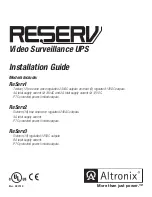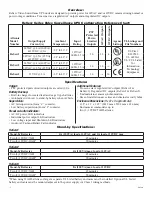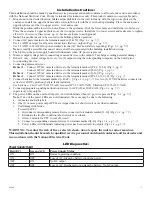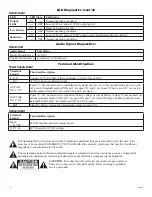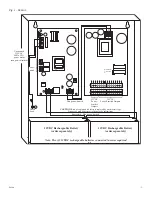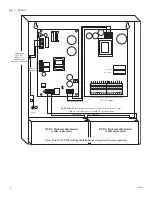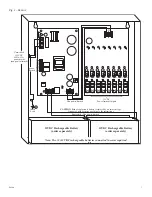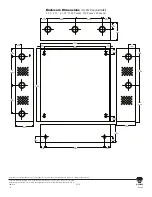
ReServ
- 3 -
Installation Instructions:
This installation should be made by qualified service personnel and should conform to all local codes and in accordance
with the National Electrical Code. Product is intended for indoor use only. This product contains no serviceable parts.
1. Mount unit in the desired location. Mark and predrill holes in the wall to line up with the top two keyholes in the
enclosure. Install two upper fasteners and screws in the wall with the screw heads protruding. Place the enclosure’s
upper keyholes over the two upper screws, level and secure.
Mark the position of the lower two holes. Remove the enclosure. Drill the lower holes and install the two fasteners.
Place the enclosure’s upper keyholes over the two upper screws. Install the two lower screws and make sure to tighten
all screws (Enclosure Dimensions, pg. 8). Secure enclosure to earth ground.
Note: This product needs to be secured to the building before operation.
2. Connect AC power mains to the terminals marked [L & N] (Figs. 1-3, pg. 5-7).
Use 18 AWG or larger for all power connections (Battery, output) (Figs. 1-3, pg. 5-7).
Use 18 AWG to 22 AWG for power-limited circuits (AC Fail/Low Battery reporting) (Figs. 1-3, pg. 5-7).
Note: A readily accessible disconnect device shall be incorporated in the building installation wiring.
3. The LEDs on the power supply board will illuminate when AC power is present.
4. Measure output voltage before connecting cameras/devices to the outputs. This helps avoiding potential damage.
5. ReServ3 only - Adjust voltage for every two (2) outputs using the corresponding trimpot(s) on the board prior
to connecting devices.
6. Connecting cameras/devices:
ReServ1 - Connect 12VDC cameras/devices to the terminals marked [P 1-4, N 1-4] (Fig. 1, pg. 5).
Connect 24VAC cameras/devices to the terminals marked [5-16] (Fig. 1, pg. 5).
ReServ2 - Connect 24VAC cameras/devices to the terminals marked [1-16] (Fig. 2, pg. 6).
ReServ3 - Connect 12VDC cameras/devices to the terminals marked [P 1-16, N 1-16] (Fig. 3, pg. 7).
7. Connect batteries to the terminals marked [-- BAT + ] (Figs. 1-3, pg. 5-7). Use two (2) 12VDC batteries connected in
series for 24VDC operation (battery leads included).
Use batteries - Casil CA1270 (12V/7AH), Genesis NP7-12 (12V/7AH), Ultratech UT1270 (12V/7AH).
8. Connect appropriate signaling notification devices to AC FAIL & BAT FAIL (Figs. 1-3, pg. 5-7)
supervisory relay outputs.
9. The power LEDs on the unit for Outputs 1-16 will illuminate when AC power is present (Figs. 1-3, pg. 5-7).
Note: If any of the power LEDs are not illuminated, the cause may be due to the following:
a. AC mains and battery fail.
b. One (1) or more power output PTCs are tripped due to a short circuit or overload condition.
c. Unit damaged/defective.
To reset the PTC:
1. Disconnect corresponding camera/device connected to terminals marked [1-16] (Figs. 1-3, pg. 5-7).
2. Eliminate the trouble condition (short circuit or overload).
3. Allow 1 minute for PTC to cool off (reset).
4. Connect corresponding cameras/devices to terminals marked [1-16] (Figs. 1-3, pg. 5-7).
5. Power LEDs will illuminate indicating power has been restored to outputs (Figs. 1-3, pg. 5-7).
WARNING: To reduce the risk of fire or electric shock, do not expose the unit to rain or moisture.
This installation should be made by qualified service personnel and should conform to all local codes and
in accordance with the National Electrical Code.
LED Diagnostics:
Power Supply Board
Red (DC)
Green (AC1)
Power Supply Status
ON
ON
Normal operating condition.
ON
OFF
Loss of AC. Stand-by battery supplying power.
OFF
ON
No DC output.
OFF
OFF
Loss of AC. Discharged or no stand-by battery. No DC output.

